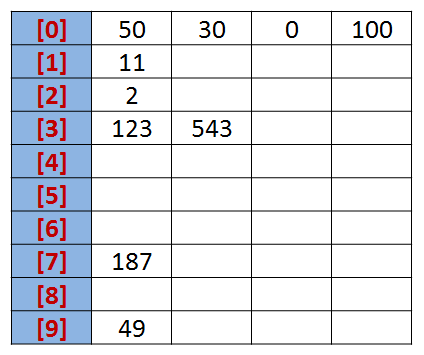基数排序与本系列前面讲解的七种排序方法都不同,它不需要比较关键字的大小。
它是根据关键字中各位的值,通过对排序的N个元素进行若干趟“分配”与“收集”来实现排序的。
1 示例
通过一个具体的实例来展示一下,基数排序是如何进行的。
设有一个初始序列为: R {50, 123, 543, 187, 49, 30, 0, 2, 11, 100}。
我们知道,任何一个阿拉伯数,它的各个位数上的基数都是以0~9来表示的。
所以我们不妨把0~9视为10个桶。
我们先根据序列的个位数的数字来进行分类,将其分到指定的桶中。例如:R[0] = 50,个位数上是0,将这个数存入编号为0的桶中。

分类后,我们在从各个桶中,将这些数按照从编号0到编号9的顺序依次将所有数取出来。
这时,得到的序列就是个位数上呈递增趋势的序列。
按照个位数排序: {50, 30, 0, 100, 11, 2, 123, 543, 187, 49}。
接下来,可以对十位数、百位数也按照这种方法进行排序,最后就能得到排序完成的序列。
1
2
3
4
5
6
7
8
9
10
11
12
13
14
15
16
17
18
19
20
21
22
23
24
25
26
27
28
29
30
31
32
33
34
35
36
37
38
39
40
41
42
43
44
45
46
47
48
49
50
51
52
53
54
55
56
57
58
59
60
61
62
63
64
65
66
67
68
69
70
71
72
73
74
75
76
| public class RadixSort {
public int getDigit(int x, int d) {
int a[] = {
1, 1, 10, 100
};
return ((x / a[d]) % 10);
}
public void radixSort(int[] list, int begin, int end, int digit) {
final int radix = 10;
int i = 0, j = 0;
int[] count = new int[radix];
int[] bucket = new int[end - begin + 1];
for (int d = 1; d <= digit; d++) {
for (i = 0; i < radix; i++) {
count[i] = 0;
}
for (i = begin; i <= end; i++) {
j = getDigit(list[i], d);
count[j]++;
}
for (i = 1; i < radix; i++) {
count[i] = count[i] + count[i - 1];
}
for (i = end; i >= begin; i--) {
j = getDigit(list[i], d);
bucket[count[j] - 1] = list[i];
count[j]--;
}
for (i = begin, j = 0; i <= end; i++, j++) {
list[i] = bucket[j];
}
}
}
public int[] sort(int[] list) {
radixSort(list, 0, list.length - 1, 3);
return list;
}
public void printAll(int[] list) {
for (int value : list) {
System.out.print(value + "\t");
}
System.out.println();
}
public static void main(String[] args) {
int[] array = {
50, 123, 543, 187, 49, 30, 0, 2, 11, 100
};
RadixSort radix = new RadixSort();
System.out.print("排序前:\t\t");
radix.printAll(array);
radix.sort(array);
System.out.print("排序后:\t\t");
radix.printAll(array);
}
}
|
运行结果:
1
2
| 排序前: 50 123 543 187 49 30 0 2 11 100
排序后: 0 2 11 30 49 50 100 123 187 543
|
2 算法分析
| 排序类型 |
排序方法 |
平均情况 |
最坏情况 |
最好情况 |
空间复杂度 |
稳定性 |
复杂度 |
| 基数排序 |
基数排序 |
O(d(n+r)) |
O(d(n+r)) |
O(d(n+r)) |
O(n+r) |
稳定 |
较复杂 |
时间复杂度
通过上文可知,假设在基数排序中,r为基数,d为位数。则基数排序的时间复杂度为**O(d(n+r))**。
我们可以看出,基数排序的效率和初始序列是否有序没有关联。
空间复杂度
在基数排序过程中,对于任何位数上的基数进行“装桶”操作时,都需要n+r个临时空间。
算法稳定性
在基数排序过程中,每次都是将当前位数上相同数值的元素统一“装桶”,并不需要交换位置。所以基数排序是稳定的算法。
参考链接
